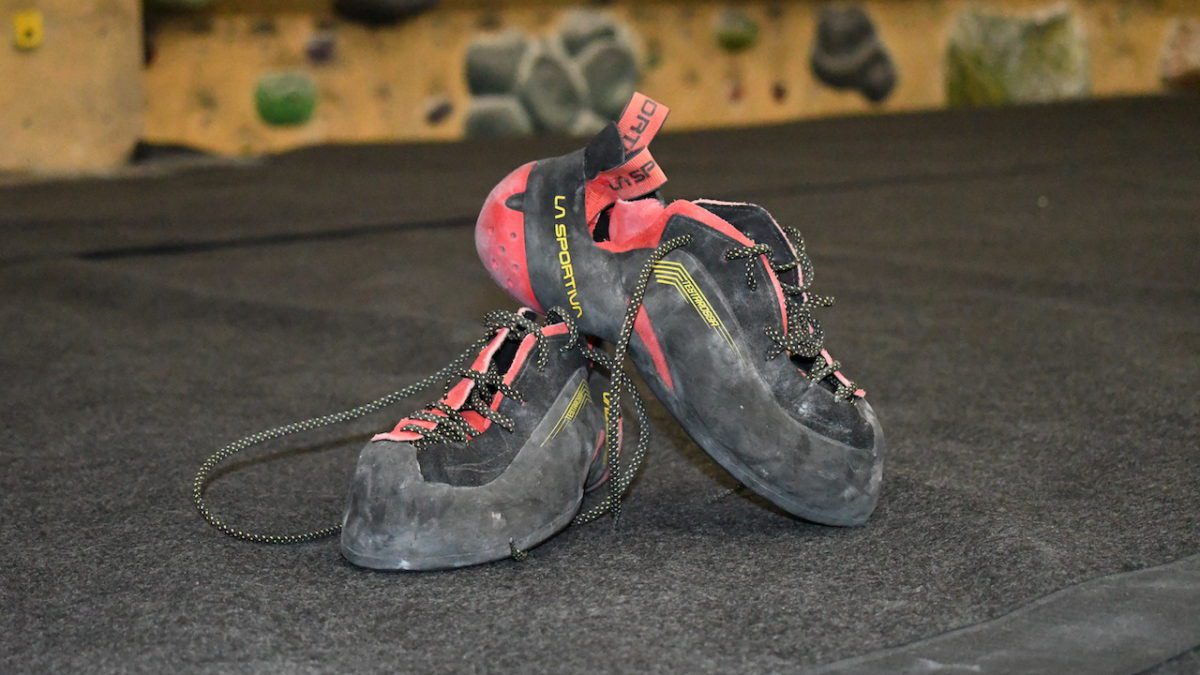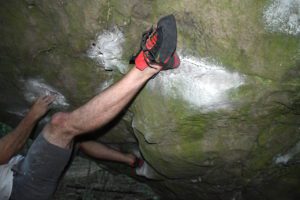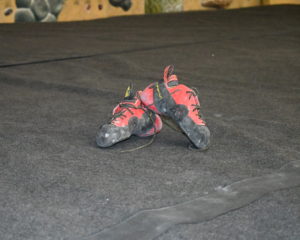Rebuilt and Reborn – La Sportiva Testarossa
Italy's La Sportiva Testarossa cuts harder and sharper than its predecessor. This is a performance rock shoe.

It isn’t limited to route climbing. La Sportiva’s newly refurbished Testarossa provides climbers with one of the most severely downturned shoes on the market. The Testarossa is unique.

Although it’s tempting to lump shoes of similar closure systems into similar boxes, the Testarossa differs from other lace ups. In the last decades, lace ups have gone in and out of style.
Where Velcro provides an in-the-gym ease of access, lace ups provide a razor’s edge by which a person can pare their project down to a few technical foot placements. Although many climbing shoes work just as well outside as they do inside, the Testarossa finds its purpose outdoors. That purpose is power.
The entire shoe is built around delivering through the forefoot. It is old school and hardcore. The comprehensive design comes complete with modern adaptations. The leather in-sole of the shoe stretches from the midfoot through to the big toe. From the midfoot, the heel wraps in a synthetic Lorica to resist the stretch from the forefoot. This allows the in-sole to stretch in the places of applied pressure, ultimately providing a progressively more snug fit as the user tightens the laces on the stretching system. In this way, the shoe becomes increasingly sensitive as it breaks in.
As the leather meets the end of the shoe, the materials change to wrap the upper in the aforementioned lorica. The synthetics keeps the toes from stretching beyond the edge of the shoe. By restraining the ultimate slip of the forefoot, the the shoe retains a difficult to dismantle structure. In leather-exclusive shoes, it is common to have the big toe stretch beyond the toe’s edge. This can split the toe open.

In low tension shoes, sensitivity often works against the shoe’s ability to stand on dime-thin edges. Often, a sensitive shoe will utilizes thin rubber and a pliant design to envelope the surface it is applied. Although this sensitivity may allow the climber to feel the foot hold, it doesn’t necessarily provide the power necessary to drive through the toe. By pushing against the tension of the P3 band, as well as the further tension provided by the snug fit and lacing system, the hooked toe of the Testarossa gives a full range of power on the tiniest edges in the steepest overhangs.
Despite it’s downturn, the Testarossa retains the stiffness a person might expect. Instead, it provides a sticky solution to the stiffness problem. The Vibram XS Grip 2 rubber pairs with the comprehensive tensioning system to allow the climber friction and power.
Although this shoe earned its reputation through route climbing, boulderers will appreciate the precision with which the shoe asserts itself. It excels primarily on steeper angels and pocketed feet. The heel differs from its predecessor and offers a durable solution to the heel hooking problem. The uniform structure rotates through mantels, while the Grip 2 insert makes it a reliable perching platform.
Due to the sheer fragility of the old model’s heel, the new heel appears more useful for more heel hooks. It only falters on the most most technical of gib-based heel hooks. Furthermore, the Testarossa’s general rigidity provides a solid and comfortable base for heel-toe cams.

With that said, the shoe has two weaknesses. It lacks toe rubber and it struggles on smears. The severe downturn of the shoe, in addition to the lack of toe-rubbers make it poor on sloping toe-hooks.
Furthermore, the shoe struggles on smeary slab. With that said, it excels on edgy slab. For context, many granite slabs in Squamish, despite their smeary appearance, actually feature numerous granite crystals. These micro edges fit well within the Testarossa’s wheel house. However, sloping smears made of featureless lime or sandstone provide less forgiveness. The shoe is rigid. It doesn’t envelop the hold. It stands on grips. If you don’t use it precisely, it will falter on smears.
Overall, the shoe makes ups up for this in its performance on an angle. It is a weapon of board climbing that both Ravioli Biceps and Jonathan Siegrist have gotten a lot out of. The downturn allows the climber to extend on the wall, all while maintaining security low down. In more physical outdoor bouldering, it continues to impress in much the same way. On sandstone and limestone edge climbing, It is difficult to thing of a shoe that might outperform the Testarossa.
Perhaps what this shoe is made for, however, is multi-angle sport climbing. It is a multi-tool that doesn’t falter when the angle changes. Instead, it continues upward taking well to the powerful style of limestone overhangs. To that effect, it is a weapon in heel-toe-cam-heavy sandstone caves. The heel is comfortable and easy to rest on. Once recovered, the severe hook and asymmetry of the forefoot provides the lower body space to rest. You can relax against the tension of the shoe.
Buy it here.



